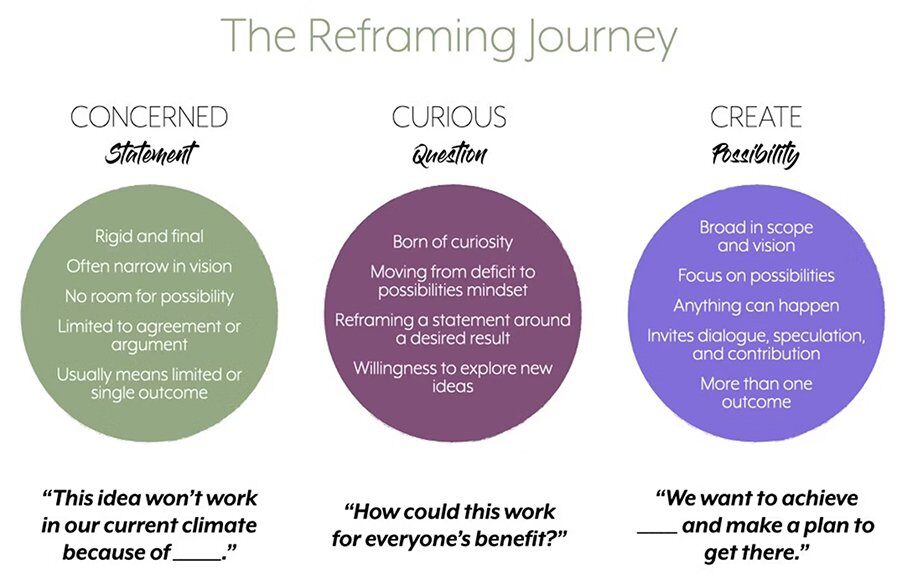How Reframing Turns Problems Into Opportunities
Reframe, reframe, reframe.
Reframing is a potent exercise for turning difficulties into chances to grow. Achieving balance in our lives and professions is dependent on how we reframe the challenges we face. Instead of focusing on worry or blame, we ask ourselves, "This is the problem, so what is the opportunity I can find in it?"
When we reframe, we step back and look carefully at a statement or a situation. It means adopting a different outlook on something and finding a different way to communicate our concerns and intentions. But most of all, it means turning a statement into a question.
What follows is a deeper look at reframing.
From Stating to Creating
Reframing is about shifting from a deficit mindset to a possibilities mindset. These three words are the path away from fear, doubt, and blame:
-
Concerned is a statement
-
Curious is about possibility
-
Create represents an opportunity

Statements are mired in finality; we either agree with them or we argue about them. In other words, statements remove all room for possibility. But when we shift to asking questions instead of relying on statements to define our future, we have the power of possibility on our side.

The simplest way to reframe something is to turn a statement into a question, as you see in the example above. You can learn the process in a few minutes, and use it for a lifetime. Moving our conversations through this spectrum is how we maintain our sense of balance.
How Reframing Helps Bring Balance
Challenges in education come at us from every angle, so our ability to reframe a problem as an opportunity is crucial to maintaining balance. The very process of stepping back from a problem and reconsidering it calms us down and clears the path for deeper thinking. Every time we seek to reframe a crisis into something constructive, we strengthen ourselves as individuals and as a collective.
“Achieving balance in our lives and professions is dependent on how we reframe the challenges we face.”
Aside from teachers, nobody in a school benefits from experiencing balance more than our learners do. You know instantly when you experience balanced learning environments simply by looking around you.
In this environment, learning is collaborative and harmonious, and the work is challenging in a way that sparks interest and excitement. As a result, teachers and students are happy and focused. In short, in balanced learning environments, everything just works.
What You'll See in a Balanced Environment
Here are just some of the things that you'll find are part of a truly balanced learning environment:
-
Students ask more questions and get curious when they are engaged and shouldering the responsibility for learning.
-
Questions are more important than answers. These are the essential questions that spark real learning.
-
Learning is personalized in terms of the curriculum, pedagogy, and the learning environment itself. It also incorporates the endless possibilities in front of us every day for creating teachable moments.
-
Assessment is mindful. Ultimately, the best assessment we can use with our students is formative assessment.
-
Criteria for success are balanced and transparent. This involves allowing students to participate in the development, application, and reporting of assessments as much as possible.
-
Learning habits are constantly modelled since teachers are the best models for learners in terms of behaviour and demonstrating how to make learning choices.
-
There are constant opportunities for practice. Getting feedback and not having the opportunity to act on it is limiting and counter-productive. Students must have opportunities to utilize what the feedback we give is meant to teach them.
Reframing the Future
The expression "new normal" is a common one, but it is a misnomer in education. That's because there's nothing normal or ordinary about teaching and learning. It is, in fact, extraordinary in its capacity for presenting the unexpected from moment to moment. For this reason, the skill of reframing is indispensable for any teacher.
Reframing does indeed lead to balance, and our learners operate in their highest capacity when surrounded by positive relationships and balanced environments. Modelling that balance through reframing in the classroom turns every problem into an opportunity to excel.
